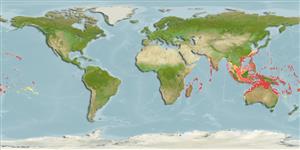Environment: milieu / climate zone / depth range / distribution range
экология
морской ассоциированный с рифами; пределы глубины 4 - 100 m (Ref. 6390). Tropical; 30°N - 33°S, 33°E - 134°W (Ref. 5222)
Indo-Pacific: Kenya to Delagoa Bay, Mozambique, eastward to the Tuamoto Islands, north to the Ryukyu Islands, south to Queensland, Australia and including most islands of the Indian Ocean and of western and central Pacific. Unknown in the Red Sea and Persian Gulf. Misidentified as Plectropomus maculatus by some authors (Ref. 6448, 6892).
Length at first maturity / Size / Вес / Возраст
Maturity: Lm ?, range 60 - ? cm
Max length : 125 cm TL самец/пол неопределен; (Ref. 30573); common length : 84.0 cm SL самец/пол неопределен; (Ref. 37816); наибольший вес (опубликованные данные): 24.2 kg (Ref. 40637)
колючие лучи спинного плавника (общее число): 7 - 8; членистые (мягкие) лучи спинного плавника (общее число): 10-12; колючие лучи анального плавника 3; членистые (мягкие) лучи анального плавника: 8.
A voracious piscivore inhabiting coral-rich areas of lagoon and seaward reefs. Encountered most frequently in channels and outer shelf reefs. Migrate over short distances to spawn, forming large aggregations, maybe 1 or 2 per reef (Ref. 6390). Feeds mostly on fishes, and occasionally on crustaceans (Ref. 9710). The prey comprises a variety of large reef fishes, including groupers, and this diet of large fishes is responsible for the high concentrations of ciguatera toxins. Juveniles may mimic the pufferfish Canthigaster valentini. Usually wary (Ref. 9710). The young have a demersal existence in shallow water in reef habitats, especially around coral rubble (Ref. 27259). They feed on small fish and invertebrates such as crustaceans and squid (Ref. 27261). Eggs float just below the surface (Ref. 6390). The pelagic larvae are found in habitats similar to those of the adults (Ref. 27260). An excellent table fish (Ref. 6390).
Heemstra, P.C. and J.E. Randall, 1993. FAO Species Catalogue. Vol. 16. Groupers of the world (family Serranidae, subfamily Epinephelinae). An annotated and illustrated catalogue of the grouper, rockcod, hind, coral grouper and lyretail species known to date. Rome: FAO. FAO Fish. Synop. 125(16):382 p. (Ref. 5222)
Статус Красного Списка МСОП (Ref. 130435)
Угроза для людей
Reports of ciguatera poisoning (Ref. 1602)
Использование человеком
рыболовство: коммерческий; объект спортивного рыболовства: да
дополнительная информация
ссылкиаквакультура (рыбоводство)особенности рыбоводствастепень растяжениягенетикаElectrophoresesнаследуемостьболезниобработкаNutrientsMass conversion
инструменты
Специальные отчеты
Скачать в формате XML
ресурсы в Интернет
Estimates based on models
Preferred temperature (Ref.
123201): 25.5 - 28.9, mean 27.6 °C (based on 276 cells).
Phylogenetic diversity index (Ref.
82804): PD
50 = 0.5078 [Uniqueness, from 0.5 = low to 2.0 = high].
Bayesian length-weight: a=0.01000 (0.00609 - 0.01643), b=3.07 (2.93 - 3.21), in cm total length, based on LWR estimates for this species & (Sub)family-body (Ref.
93245).
Trophic level (Ref.
69278): 4.1 ±0.57 se; based on food items.
устойчивость к внешним воздействиям (Ref.
120179): средний (среднего размера), минимальное время удвоения популяции 1.4-4.4 года (Preliminary K or Fecundity.).
Fishing Vulnerability (Ref.
59153): High vulnerability (61 of 100).
Nutrients (Ref.
124155): Calcium = 20.8 [13.2, 35.1] mg/100g; Iron = 0.482 [0.266, 0.777] mg/100g; Protein = 18.7 [16.9, 20.3] %; Omega3 = 0.133 [0.090, 0.206] g/100g; Selenium = 47.6 [28.5, 84.4] μg/100g; VitaminA = 76.1 [28.9, 230.2] μg/100g; Zinc = 0.698 [0.493, 0.988] mg/100g (wet weight);
